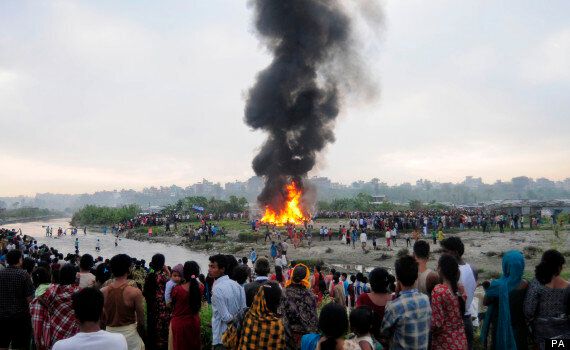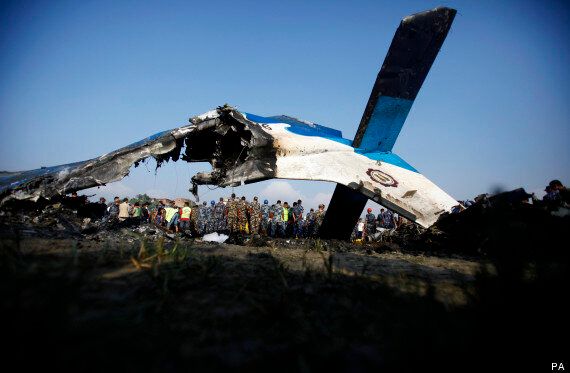The Foreign and Commonwealth Office has confirmed that seven British men have been killed in a plane crash in Nepal.
Nepalese police said the Britons were among 19 people on board, all of whom were killed when the plane crashed after reportedly hitting a vulture shortly after take-off near Nepal's capital, Kathmandu.
The twin-engine propeller plane, belonging to the domestic Sita Air, crashed near the Manohara River to the south west of the city. It had taken off just minutes earlier.

Villagers look on to the site of the crash
The plane was heading east towards Lukla, the gateway to Mt Everest and a popular destination for trekkers. Witnesses say it burst into flames and came down in a field, reports said.
Four Nepalese crew members, two Italians and six Chinese nationals are also amongst the dead.
The Foreign and Commonwealth Office have named the seven men. British Ambassador to Nepal, John Tucknott, speaking earlier today said: "Our thoughts at the moment are with the friends and families of those who lost their lives this morning.
"We will be offering consular assistance to the families of those bereaved.
"We’ve had excellent cooperation from the Nepalese authorities and the Nepali Police and have been in touch with the local tour company who were arranging the tour for those British nationals we believe to have been on board."
The pilot reported trouble two minutes after take-off and Kathmandu airport official Ratish Chandra Suman said the plane appeared to have been trying to turn back to the airport. The official could not confirm if the plane was already on fire before it crashed.
Weather in Kathmandu was clear at the time of the crash.

Seven Britons are believed to have died in the tragedy
The airport's police chief, Narayan Bastakoti, said firefighters brought the fire in the wreckage under control and police rescuers were trying to pull out the bodies. He also confirmed that seven passengers were British and five were Chinese.
The other three passengers and the four crew members were from Nepal, he said.
Thousands of Westerners head to the Himalayas every year to trek in the region around Mt Everest, the world's highest peak. Autumn is considered the best time to trek in the area.
A spokeswoman for local travel company Sherpa Adventures said the group had arrived in Nepal on Wednesday and were due to begin trekking today.
She said they were on their way to the Khumbu area in the north east of the country, also known as the Everest region.
They were due to be trekking until October 16 and were with two Nepalese leaders.
Footage taken by witnesses using mobile phones showed the front section of the plane was on fire when it first hit the ground, and that it appeared the pilot had attempted to land the plane on open ground beside a river.
The fire quickly spread to the rear, but the tail was still in one piece at the crash site, reported to be near a slum about 500m from Kathmandu's Tribhuwan International Airport.
Villagers were unable to approach the plane because of the fire and it took some time for firefighters to reach the area and bring the blaze under control.
Soldiers and police sifted through the crash wreckage looking for bodies and documents to help identify the victims.
Bodies were taken by vans to the city's hospital morgue.
Investigators were trying to determine the cause of the crash and identify the bodies, and Mr Suman said he could not confirm if the plane was already on fire before it crashed.

The crash is believed to have been caused by a bird strike
The flight was one of the first to take off from Kathmandu's airport, and departed at about 6.15am local time.
Other flights reported no problems, and the airport was operating normally.
English mountaineer Alan Hinkes, who has been climbing in the Himalayas for more than 20 years, told the BBC that he had taken the flight from Kathmandu to Lukla many times previously, and that problems usually occurred at the Lukla end.
He said: "It is ironic that it has crashed in Kathmandu. You are usually worried about it happening at the other end.
"The landing strip in Lukla is a bit like an aircraft carrier with a mountain at the end of it, with a 1,000ft drop at the end of the runway. Normally crashes happen at that end."
Mr Hinkes said it was unlikely the victims would have been planning to climb Everest, but were more likely to be trekkers or people attempting other mountains in the Everest region.
He said: "There is quite good weather in October and November for climbing the mountains around Everest.
"It is a bit worrying and upsetting. There are a lot of people and friends I know who go out at this time of year leading treks.
"It is quite alarming. I have lost a few friends in plane crashes in Nepal over the last 20 years.
"It is not the safest place to fly, I must admit, but it is what you have to do to get into the mountains."

The location of the plane crash
A spokeswoman for the Foreign Office said: "The British embassy can confirm that there was an air crash near Kathmandu airport earlier this morning.
"We can confirm that there were British national fatalities. The embassy remains in contact with the Nepalese authorities.
"The ambassador has already gone to Tribhuvan University Teaching Hospital."
The Foreign Office has set up a helpline for concerned relatives on 0207 008 1500.
Witnesses said they heard screaming coming from inside the plane before it crashed.
Harimaya Tamang, who lives near the crash site, said: "The plane appeared to be on fire already before it landed.
"We thought the pilot was trying to force land because it was on fire and the river area had open space to land.
"The plane hit the ground, bounced once but it did not break. The plane was already on fire, the local people rushed with buckets and tried to put out the flames but it was too hot and people could not get close enough."
The Foreign Office said John Tucknott, the British Ambassador to Nepal, was visiting Tribhuvan University Teaching Hospital.